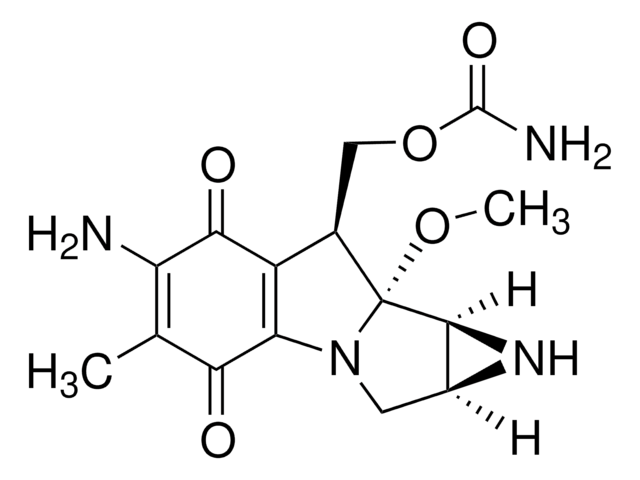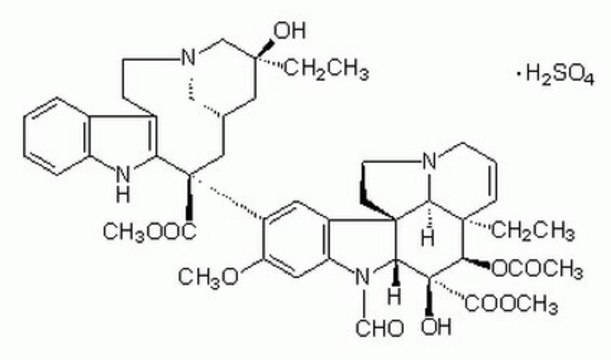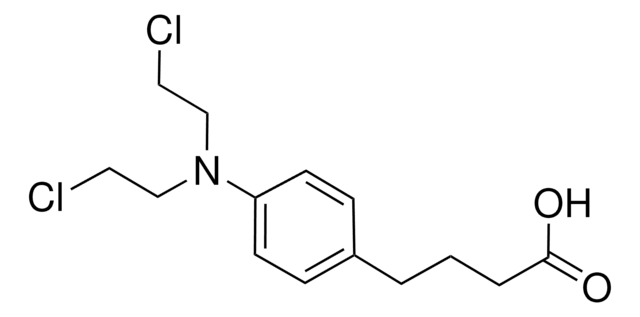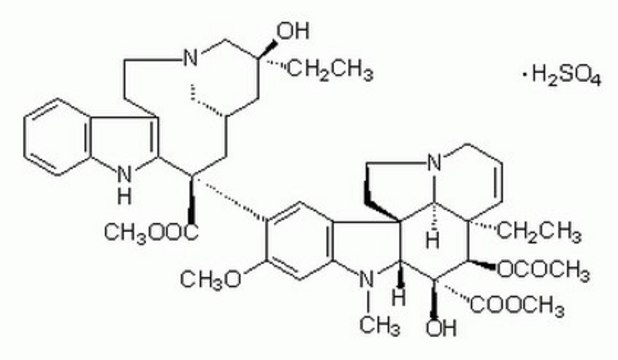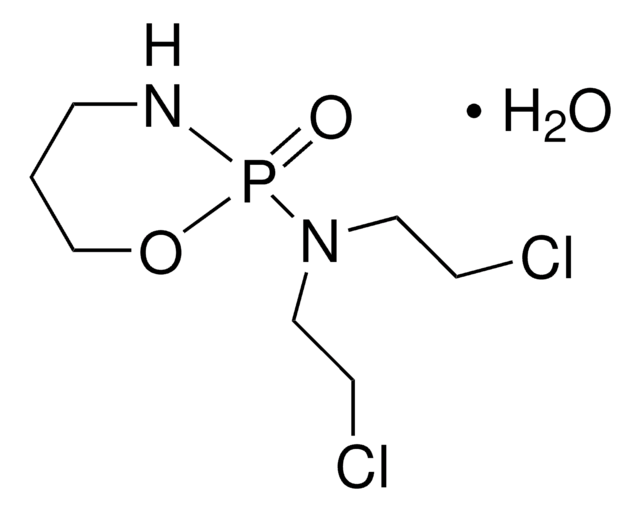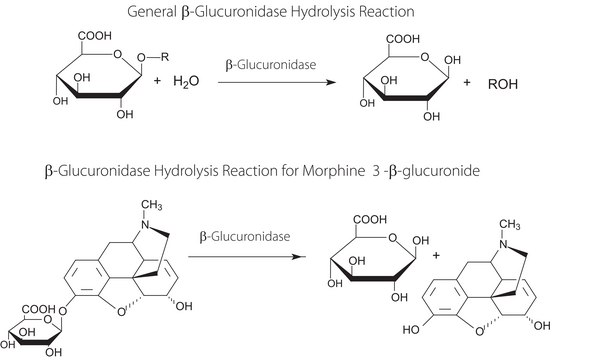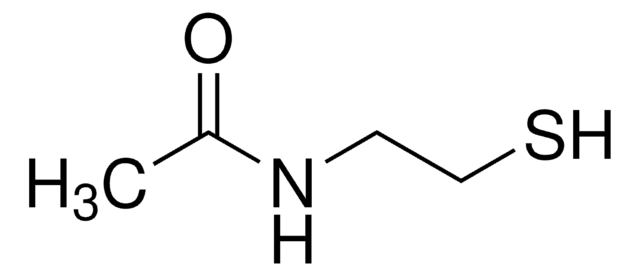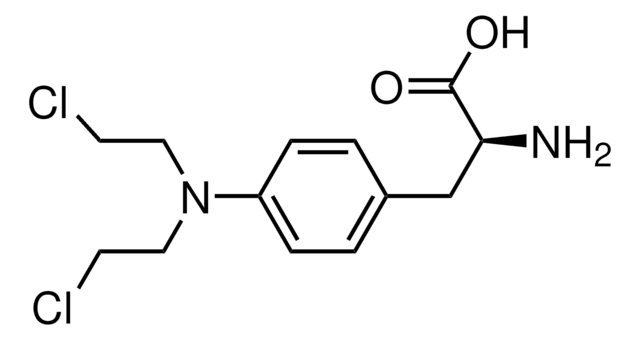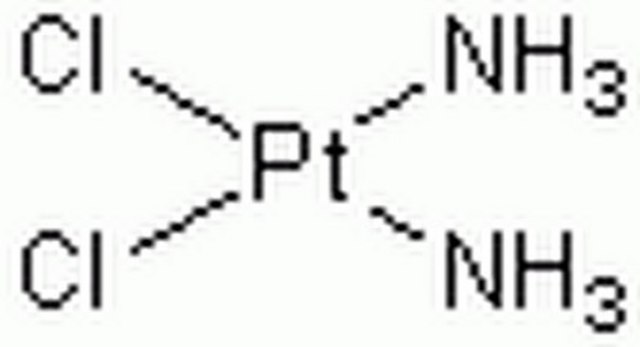SMB01361
Phosphoramide mustard cyclohexylamine
≥95% (HPLC)
Sign Into View Organizational & Contract Pricing
All Photos(1)
Synonym(s):
N,N-Bis(2-Chloroethyl)phosphorodiamidic acid, cyclohexylamine, Friedman acid, cyclohexylamine, PAM cyclohexylamine, PM cyclohexylamine, PMC, Phosphamide mustard, Cyclohexylamine, Phosphorodiamidic mustard, Cyclohexylamine
Linear Formula:
C4H11Cl2N2O2P · C6H13N
Recommended Products
Quality Level
Assay
≥95% (HPLC)
form
solid
storage temp.
-10 to -25°C
SMILES string
ClCCN(P(N)(O)=O)CCCl.NC1CCCCC1
InChI
1S/C6H13N.C4H11Cl2N2O2P/c7-6-4-2-1-3-5-6;5-1-3-8(4-2-6)11(7,9)10/h6H,1-5,7H2;1-4H2,(H3,7,9,10)
InChI key
BGTIPRUDEMNRIP-UHFFFAOYSA-N
General description
Phosphoramide mustard cyclohexanamine, a potent cytotoxic metabolite derived from the anticancer drug cyclophosphamide, acts as a remarkable alkylating agent. It is generated from cyclophosphamide through the ring-opened tautomer of the cytochrome P450 (CYP) isoform-formed intermediate 4-hydroxycyclophosphamide. This metabolite exerts its cytotoxic effects by inducing DNA crosslinking, guanine alkylation, and the formation of DNA-protein conjugates. In a concentration-dependent manner, it specifically targets HT-1080 human fibrosarcoma cells, triggering DNA damage. An essential contributor to Cyclophosphamide′s anticancer activity, Phosphoramide Mustard Cyclohexanamine exhibits great promise for cancer research, as it has the potential to induce DNA adduct formation and activate the ovarian DNA repair response in granulosa cells.
Application
Used in the development of chemotherapeutic drugs that are known to treat cancer.
Biochem/physiol Actions
Phosphoramide mustard cyclohexanamine induces cytotoxicity by forming cross-linked DNA adducts that hinder DNA strand separation during replication. This compound destroys rapidly dividing cells and leads to DNA damage. In a study with rat ovarian granulosa cells (SIGCs), it reduced cell viability and increased DNA damage response (DDR) gene expression and protein levels. In animal models, it exhibited significant anticancer activity by inhibiting tumor growth. These findings highlight the potential of Phosphoramide mustard cyclohexanamine in cancer research
Features and Benefits
- High quality compound suitable for multiple research applications
- Compatible with a wide variety of chromatographic and spectrometry techniques
Other Notes
For additional information on our range of Biochemicals, please complete this form.
This product is intended for research purposes only, and it is not meant for human consumption.
WGK
WGK 3
Flash Point(F)
Not applicable
Flash Point(C)
Not applicable
Certificates of Analysis (COA)
Search for Certificates of Analysis (COA) by entering the products Lot/Batch Number. Lot and Batch Numbers can be found on a product’s label following the words ‘Lot’ or ‘Batch’.
Already Own This Product?
Find documentation for the products that you have recently purchased in the Document Library.
Brain and plasma pharmacokinetics and anticancer activities of cyclophosphamide and phosphoramide mustard in the rat
Genka et al.
Cancer Chemotherapy and Pharmacology, 26, 1-7 (1990)
S A M Gernaat et al.
Scientific reports, 11(1), 2707-2707 (2021-02-03)
Cyclophosphamide (CPA) dosing by body surface area (BSA, m2) has been questioned as a predictor for individual drug exposure. This study investigated phosphoramide mustard-hemoglobin (PAM-Hb, pmol g-1 Hb) as a biomarker of CPA exposure in 135 female breast cancer patients
Kendra L Clark et al.
Biology of reproduction, 102(1), 248-260 (2019-08-23)
Ataxia-telangiectasia-mutated (ATM) protein recognizes and repairs DNA double strand breaks through activation of cell cycle checkpoints and DNA repair proteins. Atm gene mutations increase female reproductive cancer risk. Phosphoramide mustard (PM) induces ovarian DNA damage and destroys primordial follicles, and
Shanthi Ganesan et al.
Toxicology and applied pharmacology, 282(3), 252-258 (2014-12-17)
Phosphoramide mustard (PM), the ovotoxic metabolite of the anti-cancer agent cyclophosphamide (CPA), destroys rapidly dividing cells by forming NOR-G-OH, NOR-G and G-NOR-G adducts with DNA, potentially leading to DNA damage. A previous study demonstrated that PM induces ovarian DNA damage
Julia Delahousse et al.
Journal for immunotherapy of cancer, 8(2) (2020-08-14)
Oxazaphosphorines (cyclophosphamide (CPA), ifosfamide (IFO)) are major alkylating agents of polychemotherapy protocols but limiting their toxicity and increasing their efficacy could be of major interest. Oxazaphosphorines are prodrugs that require an activation by cytochrome P450 (CYP). CPA is mainly metabolized
Our team of scientists has experience in all areas of research including Life Science, Material Science, Chemical Synthesis, Chromatography, Analytical and many others.
Contact Technical Service